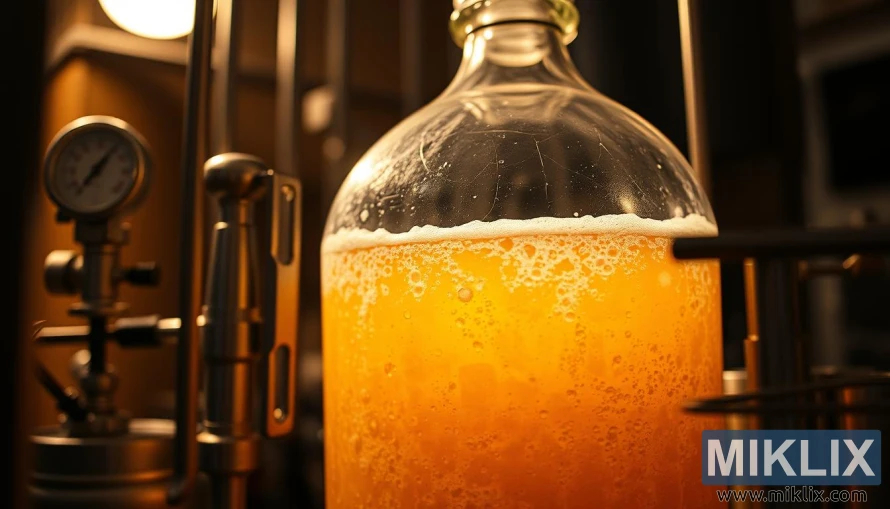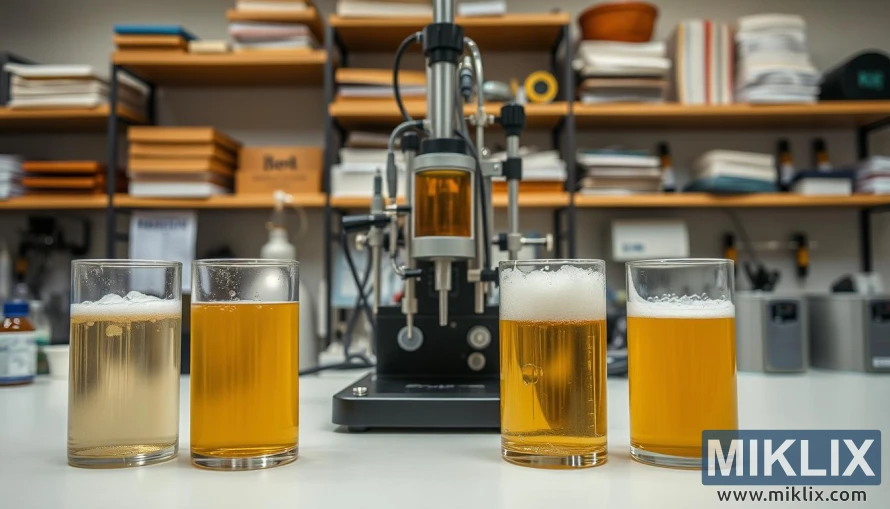Fermenting Beer with Mangrove Jack's M44 US West Coast Yeast
Published: July 20, 2025 at 11:31:10 AM UTC
Beer fermentation is a complex process that demands the perfect yeast strain for quality beers. Mangrove Jack's M44 US West Coast Yeast is a top choice for its clean flavor, ideal for American-style ales. This yeast is celebrated for its clean taste, a key factor for brewers aiming for specific beer styles. We will dive into the advantages and challenges of using Mangrove Jack's M44 US West Coast Yeast for fermentation.

Key Takeaways
- The M44 yeast strain is ideal for brewing American-style ales.
- It produces a clean flavor profile, suitable for certain beer styles.
- The yeast strain is top-fermenting, making it suitable for ale production.
- Using the right yeast strain is critical for high-quality beer fermentation.
- The characteristics of the yeast strain make it a popular choice among brewers.
Understanding Mangrove Jack's M44 US West Coast Yeast
The M44 US West Coast Yeast from Mangrove Jack's is celebrated for its exceptional flocculation and strong performance. It has gained popularity among brewers for its ability to create clean, crisp flavors. These flavors are quintessential of the US West Coast brewing style.
Mangrove Jack's M44 is known as a highly flocculant and resilient strain. It excels in cask or bottle conditioning. Its high flocculation rate allows it to form a tight, compact sediment at the bottom of the fermentation vessel. This makes it easier to achieve clear beer.
The characteristics of Mangrove Jack's M44 US West Coast Yeast can be summarized as follows:
- Highly flocculant, resulting in clear beer and compact sediment.
- Robust performance, suitable for cask or bottle conditioning.
- Produces clean, crisp flavors typical of the US West Coast style.
Understanding these properties is essential for brewers to optimize their brewing process. The yeast's attenuation and flocculation characteristics are key in determining the final flavor and clarity of the beer.
By utilizing the strengths of Mangrove Jack's M44 US West Coast Yeast, brewers can consistently produce high-quality results. These results align with the expectations of the US West Coast brewing tradition.
Technical Specifications and Performance Metrics
Understanding the technical aspects of Mangrove Jack's M44 US West Coast Yeast is key to optimizing brewing processes. This yeast strain is celebrated for its strong performance and consistent results. It's a top choice among brewers.
The technical specifications of Mangrove Jack's M44 include its alcohol tolerance, attenuation, and optimal temperature range. These factors are vital in determining the yeast's performance and the quality of the final product.
Mangrove Jack's M44 US West Coast Yeast has a high alcohol tolerance. It can ferment beers to high gravities without losing on attenuation. The yeast's attenuation properties also contribute to the beer's dryness and flavor profile.
- Alcohol Tolerance: High
- Attenuation: High
- Optimal Temperature Range: 65-75°F (18-24°C)
The optimal temperature range for Mangrove Jack's M44 is between 65-75°F (18-24°C). This is typical for many ale yeasts. Working within this range ensures the yeast performs optimally, producing the desired flavors and aromas.
In summary, Mangrove Jack's M44 US West Coast Yeast is a versatile and reliable choice for brewers. Its technical specifications and performance metrics make it well-suited for a variety of brewing applications. This includes session ales to high-gravity beers.

Optimal Fermentation Conditions
The success of fermentation with Mangrove Jack's M44 US West Coast Yeast depends on several factors. These include optimal temperature, pitching rate, and oxygen levels. Creating an ideal environment is key to achieving the desired beer characteristics.
Temperature plays a critical role in fermentation. The optimal range for Mangrove Jack's M44 US West Coast Yeast is between 59-74°F (15-23°C). This range allows the yeast to ferment efficiently and produce the desired flavor compounds.
The pitching rate also significantly affects fermentation performance. The pitching rate refers to the amount of yeast added to the wort. A proper pitching rate ensures the yeast can ferment sugars effectively without over-stressing or under-stressing the yeast cells.
- For ale fermentations, a typical pitching rate is between 0.75 and 1.5 million cells per milliliter per degree Plato.
- Adjusting the pitching rate according to the specific gravity of the wort and the desired fermentation profile is essential.
- Over-pitching can lead to reduced ester formation and potentially affect the beer's overall character.
Oxygen levels are also vital in fermentation. Adequate oxygenation is necessary for healthy yeast growth and fermentation. Yet, excessive oxygen can lead to off-flavors and affect the beer's stability.
- Ensure that the wort is adequately oxygenated before pitching the yeast.
- Monitor oxygen levels to avoid over-oxygenation, which can be detrimental to the fermentation process.
- The optimal oxygen level may vary depending on the specific beer style and yeast strain being used.
By carefully controlling these fermentation conditions, brewers can optimize the performance of Mangrove Jack's M44 US West Coast Yeast. This results in high-quality beers that meet their desired specifications.
Flavor Profile and Aroma Characteristics
Mangrove Jack's M44 US West Coast Yeast is celebrated for its clean taste and unique aroma. It's prized for creating beers with a smooth texture and low acidity. This makes it perfect for brewers aiming to craft crisp, refreshing brews.
The flavor of beers made with M44 is exceptionally clean. This allows the malt and hop flavors to stand out. It's great for hop-forward styles like IPAs and pale ales, as it enhances the hop character. The outcome is a beer that's both flavorful and well-balanced.
When it comes to aroma, M44 adds a subtle yeast note that complements the hop scent. This balance is key for beers with a complex and engaging aroma.
Some key characteristics of the flavor and aroma profile of Mangrove Jack's M44 include:
- Clean and crisp flavor
- Low acidity
- Smooth, non-astringent texture
- Accentuation of hop character
- Subtle yeast aroma
Mangrove Jack's M44 US West Coast Yeast is a versatile and dependable option for brewers. It's ideal for creating high-quality beers with distinct flavor and aroma.
Attenuation and Flocculation Properties
Mangrove Jack's M44 US West Coast Yeast stands out for its exceptional attenuation and flocculation. Attenuation is the yeast's skill in fermenting sugars, turning them into alcohol and carbon dioxide. This means the yeast can fully break down sugars, leading to a dry finish and a beer with a sharp character.
Flocculation, conversely, is the yeast's ability to clump and settle at the bottom of the fermentation vessel. This is critical for achieving a clear beer with minimal yeast haze. Mangrove Jack's M44 US West Coast Yeast has high flocculation, aiding brewers in creating a clean, bright final product.
The combination of high attenuation and flocculation in Mangrove Jack's M44 US West Coast Yeast greatly impacts brewing. Brewers can anticipate thorough fermentation, leading to a beer that is both dry and clear. This yeast is ideal for brewing styles that demand a clean, crisp taste.
- High attenuation results in a dry finish.
- Good flocculation properties lead to a clear beer.
- The yeast strain is suitable for brewing styles that require a clean flavor profile.
In summary, Mangrove Jack's M44 US West Coast Yeast's attenuation and flocculation properties are invaluable for brewers aiming to craft high-quality beers with distinct characteristics.
Compatibility with Different Beer Styles
Mangrove Jack's M44 US West Coast Yeast is versatile, fitting a wide range of beer styles. It shines in American-style ales, like American Pale Ale and Double IPA, by delivering clean, crisp flavors. Its performance in fermenting complex beers, such as American Imperial Stout, is also impressive.
The yeast's strong fermentation capabilities and adaptability make it perfect for brewers. It's ideal for those who want to explore various beer styles without sacrificing quality.
Some of the key beer styles that Mangrove Jack's M44 US West Coast Yeast is compatible with include:
- American Pale Ale
- Double IPA
- American Imperial Stout
- Other American-style ales
This yeast strain's compatibility with a range of beer styles is a significant advantage for brewers. It allows for flexibility in recipe formulation and the ability to produce high-quality beers across different styles.

Performance in High-Gravity Brewing
Many brewers are curious about Mangrove Jack's M44 US West Coast Yeast's performance in high-gravity brewing. This method involves fermenting worts with a gravity above 1.060. It poses a challenge for yeast strains.
Available data suggest that Mangrove Jack's M44 US West Coast Yeast can manage high-gravity brewing. Yet, it may show a longer lag time. Brewers should adjust their fermentation schedules to accommodate this.
Key considerations for using Mangrove Jack's M44 US West Coast Yeast in high-gravity brewing include:
- Monitoring fermentation temperature to ensure optimal yeast performance
- Adjusting nutrient levels to support yeast health and fermentation
- Being patient and allowing for potentially longer fermentation times
Understanding Mangrove Jack's M44 US West Coast Yeast's performance in high-gravity brewing helps brewers plan better. This way, they can create high-quality, full-bodied beers.
Comparison with Other West Coast Yeast Strains
Mangrove Jack's M44 US West Coast Yeast is a favorite among brewers. But how does it stack up against Fermentis SafAle US-05 or Lallemand BRY-97? Evaluating yeast strains involves looking at fermentation performance, flavor, and attenuation.
US-05 is celebrated for its clean fermentation and high attenuation. This makes it ideal for brewers aiming for a crisp, dry finish. BRY-97, on the other hand, brings a fruitier character that suits certain beer styles.
Mangrove Jack's M44 strikes a balance. It offers a neutral to slightly fruity flavor profile. Its moderate attenuation results in a beer that's dry but retains some body.
- Fermentation Characteristics: M44 ferments like US-05, with a clean and efficient profile. Yet, it produces slightly more esters, adding complexity to the flavor.
- Flavor Profile: M44's flavor is balanced, with fruity and clean notes. It's less fruity than BRY-97 but more so than US-05.
- Attenuation: M44's attenuation is similar to US-05, leading to a dry finish typical of West Coast beers.
Choosing between these yeast strains depends on the beer recipe's needs. For a traditional West Coast profile with a dry finish, M44 or US-05 might be best. BRY-97 is better for beers that want a fruitier character.
In conclusion, Mangrove Jack's M44 US West Coast Yeast is a versatile choice. It balances the clean fermentation of US-05 with a more complex flavor. Its compatibility with various beer styles and moderate attenuation make it a valuable tool for brewers.

Storage and Viability Guidelines
Optimal performance in brewing hinges on proper storage of Mangrove Jack's yeast. The right storage conditions are critical for yeast viability and quality. This directly affects the success of the brewing process.
Mangrove Jack's M44 US West Coast Yeast is sensitive to temperature and handling. Store the yeast packs in a refrigerator at 39°F to 45°F (4°C to 7°C). This temperature range slows metabolic processes, preserving yeast viability.
When handling yeast packs, avoid heat and physical stress. These factors can drastically reduce viability. Always check expiration dates and the condition of the packs before use.
Here are essential storage and handling tips for Mangrove Jack's M44 US West Coast Yeast:
- Store yeast packs in the refrigerator at a temperature between 39°F and 45°F (4°C and 7°C).
- Avoid freezing the yeast, as this can cause damage to the cells.
- Minimize handling and physical stress on the yeast packs.
- Check the expiration date before using the yeast.
- Inspect the yeast packs for any signs of damage or leakage.
Adhering to these guidelines will enhance the performance and longevity of Mangrove Jack's M44 US West Coast Yeast. This ensures consistent and high-quality brewing results.
Troubleshooting Common Issues
Addressing common problems is key to getting the best results with Mangrove Jack's M44 US West Coast Yeast. Brewers often run into issues like slow fermentation, poor attenuation, and off-flavors. These can significantly affect the quality of the final product.
One frequent problem is a longer lag time. This can be fixed by properly rehydrating the yeast and keeping the fermentation temperature just right. It's also important to check the yeast's health and activity.
To tackle slow fermentation, brewers should focus on the fermentation temperature. Mangrove Jack's M44 US West Coast Yeast is quite sensitive to temperature changes. Also, making sure the yeast has enough nutrients and pitching at the right rate can help solve these issues.
- Verify the yeast strain and its characteristics to ensure it matches the brewing plan.
- Check the fermentation environment, including temperature and pressure, to identify any problems.
- Regularly monitor the fermentation progress to spot any unexpected changes.
By understanding the reasons behind common issues and using effective troubleshooting methods, brewers can improve their use of Mangrove Jack's M44 US West Coast Yeast. This leads to better quality results.

Tips for Maximum Performance
To get the most out of Mangrove Jack's M44 US West Coast Yeast, brewers need to pay close attention to detail. They must also have a deep understanding of the yeast's characteristics. Achieving the best results hinges on creating the perfect fermentation conditions.
This means keeping the temperature steady between 65°F to 75°F (18°C to 24°C). It's also important to ensure there's enough nutrient available. Proper pitching rates are key, as under-pitching can stress the yeast and result in off-flavors.
- Pitch at a rate of 1-2 million cells per milliliter per degree Plato.
- Provide adequate nutrients, including nitrogen, vitamins, and minerals.
- Monitor fermentation temperature and adjust as necessary.
By adhering to these tips and grasping the yeast's characteristics, brewers can enhance its performance. This will lead to the creation of high-quality, full-bodied beers.
Pros and Cons Analysis
An examination of Mangrove Jack's M44 US West Coast Yeast uncovers a mix of benefits and drawbacks. It excels in producing clean, crisp flavors typical of West Coast beers. Yet, its effectiveness hinges on several factors, including the brewer's objectives, equipment, and brewing conditions.
The yeast's high points include its high attenuation, leading to a dry finish, and its strong fermentation, even at high gravities. It also boasts a neutral flavor, which enhances the malt and hop notes in the beer.
Conversely, some brewers face challenges with this yeast, such as flocculation issues and the risk of off-flavors if not managed correctly. Its high attenuation might also deter brewers aiming for sweeter beers.
To grasp the full picture, here's a concise summary:
- Advantages:High attenuation for a dry finish
- Robust fermentation performance
- Neutral flavor profile
- Disadvantages:Potential issues with flocculation
- Risk of off-flavors if not properly managed
- May not be ideal for sweeter beer styles
In conclusion, Mangrove Jack's M44 US West Coast Yeast is a valuable choice for brewing West Coast-style beers. Its suitability, though, depends on the brewer's specific requirements and goals. By weighing its pros and cons, brewers can make better decisions about its use in their brewing endeavors.
Conclusion
Mangrove Jack's M44 US West Coast Yeast stands out as a top choice for brewers aiming for excellence. It's known for its strong fermentation and clean taste, making it perfect for many beer styles. This yeast is a reliable ally in the brewing process.
For those looking to create crisp, refreshing beers, this yeast is a great option. It meets the high standards of today's beer lovers. Brewers can trust Mangrove Jack's M44 US West Coast Yeast to deliver consistent results, helping them reach their brewing aspirations.
Further Reading
If you enjoyed this post, you may also like these suggestions:
- Fermenting Beer with Wyeast 1026-PC British Cask Ale Yeast
- Fermenting Beer with Mangrove Jack's M29 French Saison Yeast
- Fermenting Beer with White Labs WLP004 Irish Ale Yeast
